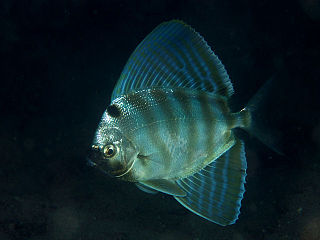
The cutlassfishes are about 45 species of predatory ray-finned fish in the family Trichiuridae of the order Scombriformes found in seas throughout the world. Fish of this family are long, slender, and generally steely blue or silver in colour, giving rise to their name. They have reduced or absent pelvic and caudal fins, giving them an eel-like appearance, and large fang-like teeth.

The Gempylidae are a family of scombriform ray-finned fishes commonly known as snake mackerels or escolars. The family includes about 25 species.

The trumpetfishes are three species of highly specialized, tubularly-elongated marine fishes in the genus Aulostomus, of the monogeneric family Aulostomidae. The trumpetfishes are members of the order Syngnathiformes, together with the seahorses and the similarly built, closely related cornetfishes.

Sailfin moonfishes are a small family, Veliferidae, of lampriform fishes found in the Indian and western Pacific Oceans. Unlike other lampriforms, they live in shallow, coastal waters, of less than 100 m (330 ft) depth, rather than in the deep ocean. They are also much smaller than most of their relatives, up to 30 cm (12 in) in length, and have deep, rather than elongated, bodies. They are characterised by their ability to retract the anterior rays of their dorsal and anal fins into a sheath.

Eomola is an extinct genus of ocean sunfish that inhabited the northeastern Tethys Ocean during the Eocene. It contains a single species, E. bimaxillaria from the Bartonian-aged Kuma Formation of Krasnodar Krai, Russia.

Eoluvarus is an extinct genus of marine ray-finned fish from the Eocene of India. It contains a single species, E. bondei from the Ypresian-aged Fuller's Earth deposits in the Kapurdi Formation of the Barmer District, Rajasthan.

Eoplectus is an extinct genus of prehistoric marine tetraodontiform fish that lived during the Eocene. It contains a single species, E. bloti from the Early Eocene-aged Monte Bolca site of Italy. It is the only member of the family Eoplectidae. It closely resembled pufferfishes and porcupinefishes, which it was related to.

Aeoliscoides is an extinct genus of prehistoric ray-finned fish that lived from the early Eocene. It is known from a single species, A. longirostris, from the famous Monte Bolca site of Italy. It was a member of Centriscidae, making it a relative of modern shrimpfish and snipefish. Its name references its close resemblance to the extant shrimpfish genus Aeoliscus.
Calamostoma is an extinct relative of the ghost pipefish that lived during the early Eocene. It contains a single species, C. lesiniforme from the famous Monte Bolca site of Italy. It is one of the few known fossil ghost pipefishes. Calamostoma and the other Bolca solenostomid, Solenorhynchus, are both placed in the extinct subfamily Solenorhynchinae.
Aulorhamphus is an extinct genus of prehistoric marine ray-finned fish that lived from the early to middle Eocene. It contains four species known from the Early Eocene of Italy and the Middle Eocene of Russia. It was an aulorhamphid, an extinct family of syngnathiform fishes.
Eolamprogrammus is an extinct genus of prehistoric marine cusk-eel that lived during the earliest Eocene. It contains a single species, E. senectus from the earliest Ypresian-aged Danata Formation of Turkmenistan. It may potentially represent an early member of the Neobythitinae.
Pietschellus is an extinct genus of enigmatic bony fish which existed in northern Italy during the early Eocene epoch. It is known from a single well-preserved nearly complete specimen recovered from the Monte Postale site of the Monte Bolca locality. It was first named by Alexandre F. Bannikov and Giorgio Carnevale in 2011 and the type species is Pietschellus aenigmaticus.

The leerfish or garrick is a species of marine fish in the family Carangidae. It is the only extant member of the genus Lichia. It is native to much of the eastern Atlantic Ocean, from the Mediterranean and western Black Sea, north to France, and south along the coastal waters of western Africa, reaching as far south as eastern South Africa. They are an important species in coastal recreational fisheries, especially in Africa.

Caruso brachysomus is an extinct species of ray-finned fish belonging to the family Lophiidae, the goosefishes, monkfishes and anglers, within the order Lophiiformes, the anglerfishes. It was described by Louis Agassiz in 1835 from the Monte Bolca locality. It became extinct during the middle Eocene.
The Matt Formation is an Early Oligocene-aged marine geological formation that outcrops in the Glarus Alps of the Canton of Glarus, Switzerland. It is most notable for its fossiliferous slates found near Engi, known as the Engi slates, Glarner Schiefer or Glarner Fischschiefer, which contain the well-preserved fossils of fishes, birds, and sea turtles. The metamorphization of the rock has led to many of the fossils appearing somewhat distorted.
The Pabdeh Formation is a Late Eocene to Early Oligocene-aged geological formation in Iran. It outcrops along the Zagros Mountains. It was deposited in a deepwater environment in the upper bathyal zone of the Paratethys Sea, with these abyssal sediments being lifted high above sea level from the uplift of the Zagros fold and thrust belt as part of the Alpide orogeny.
The Eocene-aged Monte Bolca fossil site near Verona, Italy was one of the first lagerstatte to be discovered to science, and still has one of the most prominent vertebrate faunas of all Cenozoic lagerstatte. It has the highest fish diversity of all known Cenozoic fossil sites, with many fossils having extremely detailed preservation. In addition, a very high diversity of marine invertebrates & land plants and a small number of land vertebrates are also known.

Anenchelum is an extinct genus of cutlassfish known from the early Eocene to the late Miocene. Several species are known that inhabited the northwestern Tethys and later Paratethys region, centered around east-central Europe and west Asia. This genus was synonymized with the extant Lepidopus for a time before being revived as a distinct genus in 1995.

Seriola prisca is an extinct species of prehistoric marine ray-finned fish from the Eocene. Complete fossil specimens are known from the famous Early Eocene-aged Monte Bolca site of Italy.











